Tow the Line
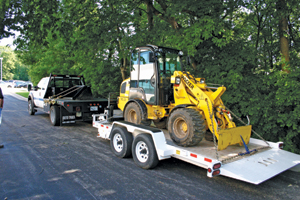 Most projects require a crew to be on the move. Jobs can span miles, contracts can cross states, some assignments even voyage overseas, but wherever the work goes, a construction professional must follow. Because the job just won’t come to the office, a contractor must take the office on the road to the job. And it’s safe to say the company’s operational tools are always in tow.
Most projects require a crew to be on the move. Jobs can span miles, contracts can cross states, some assignments even voyage overseas, but wherever the work goes, a construction professional must follow. Because the job just won’t come to the office, a contractor must take the office on the road to the job. And it’s safe to say the company’s operational tools are always in tow.
To be fully prepared to tackle a project, the right equipment must be transported to the jobsite, ready to take on the task at hand. Hauling equipment, whether its skid steers, excavators or even one of those new, cool compact wheel loaders, is an important part of getting a project finished — whether the work is across town or way out in the boonies.
The durable build and versatility of a compact wheel loader allows a contractor to complete a wide range of tasks in construction, landscape and municipal work — making it a vital machine on most types of jobsites.
“Compact wheel loaders have been gaining popularity for many applications in construction, landscaping, recycling, nurseries and material yards,” says John Sogandares, regional product specialist for the compact class of Wacker-Neuson wheel loaders. “Both the construction and landscape markets have benefited with greater jobsite productivity and decreased cost of ownership when compared to a similarly sized skid steer.”
It’s true the compact wheel loader is a versatile alternative to small tool-carrier loaders (tractors, telehandlers and skid steers). Utilizing a variety of attachments (from pallet forks to augers), a small wheel loader can instantly be beneficial on a project. But a wheel loader is also one of the largest pieces of compact equipment on the market (with some units tipping the scales at 14,000 lbs), which means extra care for contractors who must constantly transport equipment. By picking out the proper trailer and following basic loading and travel tips, a contractor can get this wheel loader workhorse rolling onto a jobsite safely and on time.
Hefty Haulers
It takes time and research to find the best compact wheel loader for a project’s requirements. So it only makes sense that a contractor needs the right equipment to get that machine to and from jobsites. While a compact wheel loader will typically weigh between 4,000 and 12,500 lbs, purchasing a truck and trailer durable enough to haul the machine is important. The first factor to take into consideration when finding a trailer is the operating weight of the wheel loader and its implements, as well as the materials used to safely secure those pieces of equipment.
“Always consider the curb weight of the loader, but do not forget to include the weights of the extra buckets, pallet forks and any other attachments,” says Sogandares. “Include the weight of chains and binders that tie down the equipment as well. The chains and binders don’t really ever seem like a great deal of weight, but if you transport multiple machines at the same time, you will have many of them and they can add up fast.”
To accommodate equipment hauling of these proportions, there is a range of trailers available for this type of task. Standard sizes of trailers come in lengths of 16, 18, 20 and 24 ft, with widths of 82 and 102 ft. Tandem axles are suggested for this kind of hauling and a utility tag trailer with a ramp is one of the most common types of trailers used to move compact equipment. “A tag trailer attaches to a receiver hitch at the rear bumper area of the tow vehicle,” explains Shawn Myers, technical specialist for Bri-Mar, a manufacturer of hydraulic dump trailers, equipment haulers and tilt trailers. Gooseneck trailers are also a good choice when maneuvering this type of load. This type of trailer employs the use of a long “neck” to reach up, over and down into the bed area of a pickup where it attaches to an appropriate receiver hitch.
“If you’re working in a very tight area without much room to turn around, a fifth wheel or gooseneck trailer is a good option,” says Sogandares. “If cost is a major issue and working space is not a concern then a tag or bumper hitch trailer can be a good choice.”
These types of trailers can range in price from $5,000 to $15,000, depending on the style and size. While there is an abundance of trailer manufacturers all over the country, a contractor should look for a reputable manufacturer with a trailer that meets the regulations and standards for hauling equipment of this size.
“Buy a quality trailer from a known source,” advises Myers. “Do not purchase a backyard garage-made trailer for these important tasks. Make sure the trailer meets DOT standards and that its manufacturer is a member of and its trailers are certified by NATM, the National Association of Trailer Manufacturers.” (For more information on NATM, see sidebar below.)
Pairing a work vehicle to the trailer is also an important issue when hauling a wheel loader. A larger pickup (around 1 ton) might be an adequate means of transportation to pull a trailer and a small wheel loader — but every situation is unique. The bigger the unit, the more power needed to haul.
“The type of truck used for hauling depends on the size of the machine, trailer, attachments and therefore the overall gross vehicle weight [GVW],” says Joel Powell, product specialist group manager for Volvo Compact Equipment. “Some very popular trucks most often seen towing compact wheel loaders include Ford F250 through 550s and Chevy HD2500 through 3500s.”
Once a trailer is selected for moving a compact wheel loader, proper loading and traveling rules must be followed. Through correct machine and trailer practices, a contractor can get his or her machine to a jobsite safely.
Trailer MadeNATM Sets the Standards for Trailer Manufacturers
Since its inception, NATM has worked to improve the trailer industry through the promotion of compliance with Federal Safety Regulations and selected industry standards. This has been done through education, as well as the publication of the “Guidelines for Recommended Minimum Manufacturing Practices for Light- and Medium-Duty Trailers” and its compliance program. NATM compliance consultants visit members that volunteer for this program and verify that the manufacturer has the processes in place to manufacture trailers in accordance with Federal Motor Vehicle Safety Standards (FMVSS) and selected industry standards. NATM members manufacture a wide variety of trailers for use in many different industries, including construction. Contractors are encouraged to look for the NATM compliance decal, which reflects trailers that are built by manufacturers in compliance with NATM Guidelines. A complete list of compliant members can be found on the NATM Web site (www.natm.com). Visitors to the site can also search for trailers by type including utility, equipment or portable equipment trailers. For more information about the National Association of Trailer Manufacturers or its Compliance Program, contact NATM Headquarters at (785) 272-4433 or natmhq@natm.com. |
Load and Go
After a trailer is picked for hauling a compact wheel loader, it’s important to become familiar with how to load and secure the machine correctly before traveling to a project site. Two people are ideal for the loading process. One driving the loader and one directing provides an additional set of eyes.
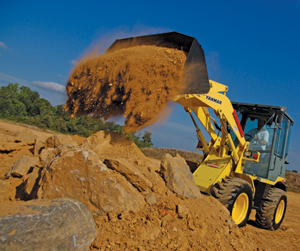
Before the machine can be loaded, there are three steps to prep the vehicle and trailer. First, find a flat area to load the machine on. It’s always best to load on a flat surface rather than on any sort of incline, notes Sam Meeker, small/compact wheel loader industry manager for Caterpillar. Next, the parking brake of the truck that’s hauling the trailer should be engaged. Then the ramp of the trailer needs to be lowered and set correctly so the machine can easily drive up onto it.
When loading the equipment, it’s recommended to keep the compact wheel loader as centered on the trailer as possible in order to distribute the weight evenly. Prior to driving the machine onto the trailer, the operator should identify the center of the trailer and keep that in mind while loading. The wheel loader may be driven onto the trailer in forward or in reverse — whichever way is most comfortable to the operator.
“Either direction is fine due to the machine’s longer wheelbases, as well as good visibility out of the front and rear of the machine and the weight distribution among the axles,” explains Powell. “Many people will probably drive in reverse up the trailer because of their familiarization with operating skid steers.”
As a safety precaution, an operator should never try to load more than one implement at a time while driving the machine. For example, if the machine is paired with forks, an operator should not try to load the machine while carrying another attachment on those forks.
“Always load one tool at a time. First, place the extra work tool on the trailer and then drive your machine and its attachment onto the trailer,” says Meeker. “If you’re going to load it with two work tools, make sure they are tied or chained to each other so that the one tool is not loose. It’s easy to dump the tool off the side and injure or even kill the person standing next to the trailer.”
When it’s time to drive the machine onto the trailer, the operator should be sure to raise or lower the bucket (or any other attachment) to avoid any damage to the trailer or the machine during the loading process.
“Drive the unit onto the trailer and remember to watch the boom and attachments as you pull onto the trailer,” says Sogandares. “Always keep your boom as low as possible as it will yield greater stability when loading.” When the machine is in place on the trailer, set its parking brake and turn off and exit the compact wheel loader.
Once the machine is loaded, it’s imperative to secure it correctly. To identify the tie-down points of a particular model, an operator should consult the machine’s operator’s manual. The manual will display these spots and the machine will usually have decals at the tie-down locations. Most wheel loaders will have one or two tie-down points on both the front and rear of the machine.
Q&A: Mindful Machine MaintenanceSam Meeker, Caterpillar Small/Compact Wheel Loader Industry Manager, Details a Basic Machine Check-up
Typical maintenance checks include engine oil level, coolant level, hydraulic oil level and battery condition. Always check the machine for material in the linkage and coupler. Major replacement parts would be the typical maintenance items. These machines are built to withstand loading rigors and do not typically fail as a lighter-duty machine would.
CE: How can you check tire wear? How can you minimize tire wear? Tire wear can be measured by the tread depth. Rimpull control by the operator is probably the best way to minimize tire wear.
CE: What type of operational tips can you share to decrease wear on a compact wheel loader? Smooth operation is the best way to minimize wear. Be sure to not drag the bucket on the ground and wear the cutting edges. CE: How can you judge a quality machine that’s going to last with minimal maintenance? Weight can be a good judge, as more metal in a machine typically shows more durable components. Balance is also important. Just look for good quality construction, heavy-duty structures and components and good design features. CE: What about winter weather tips? How can you prepare your wheel loader for working in the cold?
Specific winter weather checks would be the machine’s battery condition by testing it with a battery tester. Also check its tire pressure since that changes with temperature. Some engine manufacturers recommend different oil weights for winter, so check the operator’s manual for that information. |
Typically, a wheel loader that is 10,000 lbs and under should be fastened to the trailer using two chains — one on the front of the machine and one on the rear. If the machine exceeds that weight, additional tie-downs are required and are regulated by local and state laws. As for any attachments being hauled, two chains (one pulling forward and one pulling backward) should be sufficient, as these pieces of equipment can weigh between 300 to 1,500 lbs. Make sure that any loose material is removed out of the attachments and wheel loader, such as mud, rocks and debris, so they will not hit any traffic traveling behind the trailer, cautions Powell.
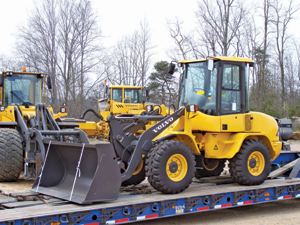
When it’s time to finally hit the road, a driver should remain cautious of his or her load. Maintaining proper tension of the tie-downs is crucial and the machine and its chains should be checked throughout the journey. “The driver should initially check the load at around 50 miles and then at least every 150 miles afterward,” says Sogandares. Obey the posted speed limits and check with the trailer manufacturer for any particular speed recommendations. If clearance is an issue on route, be sure to measure the trailer and loader before traveling. Since the compact wheel loader is smaller in size, around 7 to 9 ft, a driver should not have any problems clearing overpasses or any other overhead obstacles.
When hauling any type of equipment, it’s important to be safe and perform maintenance on the towing vehicle and its trailer. Prior to each trip, a driver should check tires and tire pressure, lug nuts, hitches, brakes and lights, says Myers. If one of these components is not working properly or is damaged, they should be repaired or replaced before traveling with the load. “It’s a must to constantly check that the trailer hitch, safety chains, breakaway cable, jacks and trailer wiring cable are secured and in good shape,” adds Sogandares. “It’s important to be vigilant about safety.”
When a project calls for a compact wheel loader, whether it’s assisting in a landscape design or moving dirt to make way for a new home, getting the machine to a jobsite is an all-important task. With the right vehicle, trailer and travel know-how, a contractor can get his or her equipment to work on time and ready to go.
Pam Stask is assistant editor of Compact Equipment, based in Peninsula, Ohio.

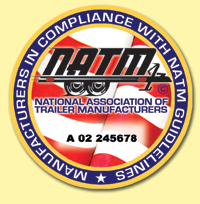 Founded in 1987, the National Association of Trailer Manufacturers (NATM) represents manufacturers that produce light- and medium-duty trailers and suppliers to the trailer manufacturing industry. The association is organized to promote a universal recognition of safety and quality in the trailer manufacturing industry to both the industry and the public.
Founded in 1987, the National Association of Trailer Manufacturers (NATM) represents manufacturers that produce light- and medium-duty trailers and suppliers to the trailer manufacturing industry. The association is organized to promote a universal recognition of safety and quality in the trailer manufacturing industry to both the industry and the public.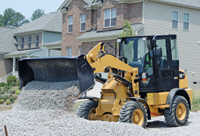 CE: What are the major maintenance checks and replacement parts on compact wheel loaders?
CE: What are the major maintenance checks and replacement parts on compact wheel loaders?
Comments are closed here.